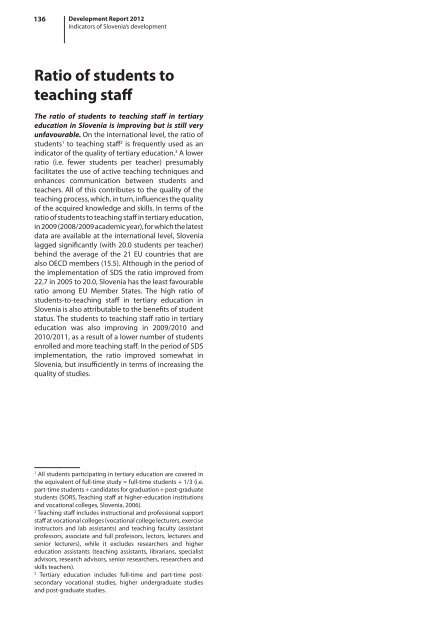development report 2012 - UMAR
development report 2012 - UMAR
development report 2012 - UMAR
You also want an ePaper? Increase the reach of your titles
YUMPU automatically turns print PDFs into web optimized ePapers that Google loves.
136 Development Report <strong>2012</strong><br />
Indicators of Slovenia’s <strong>development</strong><br />
Ratio of students to<br />
teaching staff<br />
The ratio of students to teaching staff in tertiary<br />
education in Slovenia is improving but is still very<br />
unfavourable. On the international level, the ratio of<br />
students 1 to teaching staff 2 is frequently used as an<br />
indicator of the quality of tertiary education. 3 A lower<br />
ratio (i.e. fewer students per teacher) presumably<br />
facilitates the use of active teaching techniques and<br />
enhances communication between students and<br />
teachers. All of this contributes to the quality of the<br />
teaching process, which, in turn, influences the quality<br />
of the acquired knowledge and skills. In terms of the<br />
ratio of students to teaching staff in tertiary education,<br />
in 2009 (2008/2009 academic year), for which the latest<br />
data are available at the international level, Slovenia<br />
lagged significantly (with 20.0 students per teacher)<br />
behind the average of the 21 EU countries that are<br />
also OECD members (15.5). Although in the period of<br />
the implementation of SDS the ratio improved from<br />
22.7 in 2005 to 20.0, Slovenia has the least favourable<br />
ratio among EU Member States. The high ratio of<br />
students-to-teaching staff in tertiary education in<br />
Slovenia is also attributable to the benefits of student<br />
status. The students to teaching staff ratio in tertiary<br />
education was also improving in 2009/2010 and<br />
2010/2011, as a result of a lower number of students<br />
enrolled and more teaching staff. In the period of SDS<br />
implementation, the ratio improved somewhat in<br />
Slovenia, but insufficiently in terms of increasing the<br />
quality of studies.<br />
1<br />
All students participating in tertiary education are covered in<br />
the equivalent of full-time study = full-time students + 1/3 (i.e.<br />
part-time students + candidates for graduation + post-graduate<br />
students (SORS, Teaching staff at higher-education institutions<br />
and vocational colleges, Slovenia, 2006).<br />
2<br />
Teaching staff includes instructional and professional support<br />
staff at vocational colleges (vocational college lecturers, exercise<br />
instructors and lab assistants) and teaching faculty (assistant<br />
professors, associate and full professors, lectors, lecturers and<br />
senior lecturers), while it excludes researchers and higher<br />
education assistants (teaching assistants, librarians, specialist<br />
advisors, research advisors, senior researchers, researchers and<br />
skills teachers).<br />
3<br />
Tertiary education includes full-time and part-time postsecondary<br />
vocational studies, higher undergraduate studies<br />
and post-graduate studies.
















